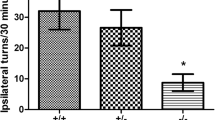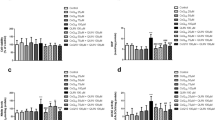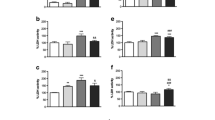Abstract
Nitric oxide (NO) is a potential contributor to neurotoxicity following overactivation of N-methyl-D-aspartate (NMDA) receptors. In this work we investigated the effect of Nω-nitro-L-arginine (L-NARG 25, 50, or 100 μM), a selective inhibitor of nitric oxide synthase (NOS) -the synthetic enzyme of NO- on quinolinic acid (QUIN 100 μM)-induced neurotoxicity (measured as lactate dehydrogenase (LDH) leakage) in rat striatal slices. Oxidative stress was also measured both as lipid peroxidation and as the levels of reduced (GSH) and oxidized (GSSG) glutathione, in an effort to elucidate a possible participation of NO in the toxic mechanisms involved in NMDA receptor-mediated neuronal injury. The action of L-arginine (L-ARG 100 or 200 μM), a well-known NO precursor, was also tested on QUIN-induced neurotoxicity and oxidative stress. Results showed that QUIN produced significant changes in both cell damage (177%) and oxidative injury (203% in lipid peroxidation, 68% in GSH, and 123% in GSSG) as compared to control values. All these effects were antagonized by adding L-NARG to the incubation media, whereas L-ARG alone, or in combination with QUIN, significantly enhanced both lipid peroxidation and LDH leakage. Moreover, the protective effects of L-NARG on QUIN-induced lipid peroxidation were reversed by addition of an excess of L-ARG to the media. These findings indicate that NO is probably mediating the mechanism of neurotoxicity produced by QUIN, which may be of potential value to explain the molecular basis of neurodegenerative processes linked to QUIN-mediated NMDA receptor overactivation.
Similar content being viewed by others
REFERENCES
Stone, T. W. 1993. Neuropharmacology of quinolinic and kynurenic acids. Pharmacol. Rev. 45: 309–379.
Heyes, M. P., Saito K., Crowley, J. S., Davies, L. E., Demitrack, M. A., Der, M., Dilling, M. A., Elia, J., Kruesi, M. J. P., Lackner, A., Larsen, S. A., Lee, K., Leonard, H. L., Markey, S. P., Martin, A., Milstein, S., Mouradian, M. M., Pranzatelli, M. R., Quearry, B. J., Salazar, A., Smith, M., Strauss, S. E., Sunderland, T., Swedo, S. W., and Tourtellotte, W. W. 1992. Quinolinic acid and kynurenine pathway metabolism in inflammatory and non-inflammatory neurological diseases. Brain 115: 1249–1273.
Schwarcz, R., Foster, A. C., French, E. D., Whetsell Jr., W. O., and Köhler, C. 1984. Excitotoxic models for neurodegenerative disorders. Life Sci. 35: 19–32.
Nathanson, J. A., Scavone, C., Scalon, C., and McKee, M. 1995. The cellular Na+ pump as a site of action for carbon monoxide and glutamate: a mechanism for long-term modulation of cellular activity. Neuron 14: 781–794.
Ríos, C., and Santamaría, A. 1991. Quinolinic acid is a potent lipid peroxidant in rat brain homogenates. Neurochem. Res. 16: 1139–1143.
Santamaría, A., and Ríos, C. 1993. MK-801, an N-methyl-D-aspartate receptor antagonist, blocks quinolinic acid-induced lipid peroxidation in rat corpus striatum. Neurosci. Lett. 159: 151–154.
Stípek, S., Stastny, F., Plateník, J., Crkovská, J., and Zima, T. 1997. The effect of quinolinate on rat brain lipid peroxidation is dependent on iron. Neurochem. Int. 30: 233–237.
Bredt, D. S., and Snyder, S. H. 1990. Isolation of nitric oxide synthase, a calmodulin-requiring enzime. Proc. Natl. Acad. Sci. U.S.A. 87: 682–685.
Garthwaite, J. 1991. Glutamate, nitric oxide and cell-cell signaling in the nervous system. Trends Neurosci. 14: 60–67.
Moncada, S., Palmer, R.M.J., and Higgs, E.A. 1989. Biosynthesis on nitric oxide from L-arginine: a pathway for the regulation of cell function and communication. Biochem. Pharmacol. 38: 1709–1715.
Lipton, S. A., Choi, Y. B., Pan, Z. H., Lei, S. Z., Chen, H. S. V., Sucher, N. J., Loscalzo, J., Singel, D. J., and Stamler, J. S. 1993. A redox-based mechanism for the neurodestructive effects of nitric oxide and related nitroso-compounds. Nature 364: 626–632.
Snyder, S. H. 1993. Janus faces of nitric oxide. Nature 364: 577.
Kashii, S., Mandai, M., Kikuchi, M., Honda, Y., Tamura, Y., Kaneda, K., and Akaike, A. 1996. Dual actions of nitric oxide in N-methyl-D-aspartate receptor-mediated neurotoxicity in cultured retinal neurons. Brain Res. 711: 93–101.
Rubbo, H., Radi, R., Trujillo, M., Telleri, R., Kalyanaraman, B., Barnes, S., Kirk, M., and Freeman, B. A. 1994. Nitric oxide regulation of superoxide and peroxynitrite-dependent lipid peroxidation. J. Biol. Chem. 269: 26066–26075.
Garthwaite, J., Garthwaite, G., Palmer, R. M. J., and Moncada, S. 1989. NMDA receptor activation induces nitric oxide synthesis from arginine in rat brain slices. Eur. J. Pharmacol. 172: 413–416.
Kiedrowski, L., Costa, E., and Wroblewski, J. T. 1992. Glutamate receptor agonists stimulate nitric oxide synthase in primary cultures of cerebellar granule cells. J. Neurochem. 58: 335–341.
Santamaría, A., Santamaría, D., Díaz-Muñoz, M., Espinoza-González, V., and Ríos, C. 1997. Effects of Nω-nitro-L-arginine and L-arginine on quinolinic acid-induced lipid peroxidation. Toxicol. Lett. 93: 117–124.
Pérez-Severiano, F., Escalante, B., and Ríos, C. 1998. Nitric oxide synthase inhibition prevents acute quinolinate-induced striatal neurotoxicity. Neurochem. Res. 23: 1297–1302.
Wroblewski, F., and LaDue, J. S. 1995. Lactic dehydrogenase activity in blood. Proc. Soc. Exp. Biol. Med. 90: 210–213.
Hissin, P. J., and Hilf, R. 1976. A fluorometric method for determination of oxidized and reduced glutathione in tissues. Anal. Biochem. 74: 214–226.
Shukla, G. S., Srivastava, R. S., and Chandra, S. V. 1988. Prevention of cadmium-induced effects on regional glutathione status of rat brain by vitamin E. J. Appl. Toxicol. 8: 355–358.
Lowry, O. H., Rosebrough, N. J., Farr, A. L., and Randall, R. J. 1951. Protein measurement with the Folin-phenol reagent. J. Biol. Chem. 193: 265–275.
Steel, R. G. D., and Torrie, J. H. 1980. Principles and procedures of statistics. McGraw-Hill, New York, NY.
Harvey, P.R.C., Ilson, R.G., and Strasberg, S.M. 1989. The simultaneous determination of oxidized and reduced glutathiones in liver tissue by ion pairing reverse phase high performance liquid chromatography with a coulometric electrochemical detector. Clin. Chim. Acta 180: 203–212.
Raps, S. P., Lai, J. C. K., Hertz, L., and Cooper, A. J. L. 1989. Glutathione is present in high concentrations in cultured astrocytes but not in cultured neurons. Brain Res. 493:398–401.
Brookes, P. S., Land, J. M., Clark, J. B., and Heales, S. J. R. 1998. Peroxynitrite and brain mitochondria: evidence for increased proton leak. J. Neurochem. 70: 2195–2202.
Zhang, J., and Piantadosi, C. A. 1992. Mitochondrial oxidative stress after carbon monoxide hypoxia in the rat brain. J. Clin. Invest. 90:1193–1199.
Author information
Authors and Affiliations
Rights and permissions
About this article
Cite this article
Santamaría, D., Espinoza-González, V., Ríos, C. et al. Nω-Nitro-L-Arginine, a Nitric Oxide Synthase Inhibitor, Antagonizes Quinolinic Acid-Induced Neurotoxicity and Oxidative Stress in Rat Striatal Slices. Neurochem Res 24, 843–848 (1999). https://doi.org/10.1023/A:1020949812581
Issue Date:
DOI: https://doi.org/10.1023/A:1020949812581




